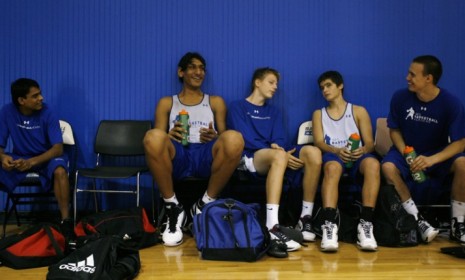Satnam Singh Bhamara: India's Yao Ming?
A gentle, 7-foot-2-inch farmer's son, says Mark Winegardner, may soon become the face of Indian basketball

Thirty or so years ago, in the Indian state of Punjab, in a tiny rural village surrounded by rice paddies, there lived a teenage boy named Balbir Singh Bhamara, who did what had once seemed impossible; he grew to be taller than his mother.
Balbir's father was a wheat farmer and miller with a string of glistening black water buffalo that gave milk as sweet as honey. His mother was 6 feet 9 inches, and young Balbir grew to be a little over 7 feet tall — the tallest person in the village.
Everywhere the boy went, people told him he ought to play basketball, a game many of them had heard about but never seen. In the cities, there were schools with proper courts where he could learn the game and, as a bonus, get an education. If he took to the game, as seemed certain, he'd have a chance to see the country, or maybe, just maybe, the world.
The Week
Escape your echo chamber. Get the facts behind the news, plus analysis from multiple perspectives.

Sign up for The Week's Free Newsletters
From our morning news briefing to a weekly Good News Newsletter, get the best of The Week delivered directly to your inbox.
From our morning news briefing to a weekly Good News Newsletter, get the best of The Week delivered directly to your inbox.
Balbir's father would hear none of it. His son would stay in the village and become a farmer. That was that. The boy obeyed, because that was what a boy did. In due course, he took over the farm and became prosperous. He married. He had three children. He was elected the head of the village.
And then one day another giant emerged: Balbir's middle child, a sweet and joyful boy named Satnam. When Satnam was 9 years old and already taller than most adults in the village, Balbir took the boy to a scruffy local court to play basketball, a game the father still barely understood. Satnam walked onto the court, utterly bewildered. He had misunderstood and thought his father was taking him to play volleyball. Predictably, the boy struggled. Balbir watched, feeling untroubled, undeterred — happy, even.
Not long after they got back home, Balbir crossed the lumpy dirt courtyard that separated his small stable and mill from his even smaller house and mounted a hoop to the weathered brick wall. Balbir summoned his son to the courtyard and handed Satnam a new rubber basketball.
The family room was right inside. At the end of the workday, while others in the family strained to hear the little TV over the kid's incessant banging of the ball against the wall, Balbir would just sit back, sip his tea with buffalo milk, stroke his long, graying beard, and grin.
A free daily email with the biggest news stories of the day – and the best features from TheWeek.com
Balbir never pushed the game on his son. It just took. Over the next several months, puzzled villagers watched as Satnam spent hour after hour in that courtyard. The already tall boy shot up, magically, as if summoned skyward by the hoop. Just like that, he was as tall as his grandmother. Satnam's hands grew so large that, to the villagers' eyes, the basketball seemed to be mysteriously shrinking. They called him Chhotu, Punjabi for "little one."
Satnam's father began asking friends and neighbors for advice and learned about a sports academy in Ludhiana, the nearest big city. It soon became Satnam's second home.
Three years ago, at the age of 13, Satnam was 6 feet 11 inches and 230 pounds, with size-18 feet, broad shoulders, a soft shooting touch, and a voice deeper than André the Giant's. Other than that? Just an ordinary, well-brought-up teenage country boy — humble, polite, shy, confused, a little goofy, perpetually embarrassed, and in every way awkward.
In both of his homes, he was loved and happy.
IN THE SUMMER of 2009, Satnam was invited to New Delhi to try out for the national junior team, which had qualified to play in the Under-16 Championship in Malaysia.
When he made the team, he was the youngest and tallest player on the roster. Weeks later and without complaint, eager to see the world, the giant boy folded himself into the seat of an airplane for a five-hour flight across the Bay of Bengal.
But the games themselves showed Satnam that his dreams were outpacing his skills. He played only a few minutes. India went 3-4 — including a 74-point beatdown at the hands of the Chinese, the eventual champs — and finished 10th out of 16 teams.
Satnam and his teammates at the academy dreamed of the NBA, but they didn't know much. They had favorite players, but these were only the biggest stars. No one Satnam knew could have named half the teams. Certainly no one had any inkling that the NBA was about to launch an aggressive effort to partner with a few multinational corporations and build Indian basketball into a sacred cash cow. The target audience: Indians under 25. In other words, one of every 12 people on the face of the earth.
IN NOVEMBER 2009, Heidi Ueberroth became the first president of NBA International. Ueberroth, who a few years before had helped launch NBA China, immediately set her sights on India, hiring a man named Troy Justice to be the league's first director of basketball operations in India. Justice's mission: Build interest in the game from the grassroots level.
Four months later, IMG, the American sports marketing and management titan, and Reliance Industries, the largest corporation in India, joined forces. As its first order of business, IMG Reliance sewed up all commercial rights to the game of basketball in India and prepared to launch its own professional basketball league. To get there, the company would attempt to build an infrastructure for Indian basketball from the ground up: facilities, coaching, tournaments, school leagues, etc. But more important to our story, IMGR announced it would provide full scholarships to train and go to school at the IMG Basketball Academy in Bradenton, Fla., whose alums include Kobe Bryant, Vince Carter, Al Harrington, and Joakim Noah. The first recipients would be four boys and four girls — the best Indian basketball players 13 years old or younger. No one, however, was quite sure how to find them.
Meanwhile, Satnam continued to grow. By the spring of 2010, he was 14 and almost as tall as his father. His shoulders and torso had broadened. His voice had grown deeper. One day that spring Satnam met Troy Justice. Satnam spoke no English. In Punjabi, his coach told him to go work on footwork with the American. The boy, mortified at his torn-up, shabby shoes, nonetheless obeyed. That was how he was raised. He willed himself to forget about his shoes. He focused on what the American, who spoke no Punjabi, was trying to teach. Justice wasn't sure he'd ever coached anyone who was more present. Afterward, a reporter asked about the giant young Punjabi. "He can be the chosen one for basketball in India," Justice said.
Three months later, in June 2010, Satnam, still 14, led Punjab's state youth team to a national championship. It was about then that officials from IMG Reliance met with Harish Sharma, the head of the Basketball Federation of India, to ask for help in identifying prospects for the scholarships. It hadn't dawned on them to consider anyone from last year's junior national team, since all, no doubt, were 16 or 17 by now. The scholarships were for kids 13 and under. Sharma's first suggestion was a boy of 14.
Too old, they told him.
"This boy, you will want to see," Sharma insisted. "I've told people many times, he can become India's Yao Ming."
And so it was that Satnam became one of 50 players chosen to try out, in July 2010, for eight scholarships. By August, before he could fully comprehend it, Satnam was 8,000 miles away in Florida, immersed in an elite young-jock version of a Benetton commercial and loving all the new food he got to eat. Back home his parents were hooking up the new computer they had bought, so they could watch their son's games on YouTube and talk to him on Skype.
In August, when Satnam first hit the courts in America, his English was nonexistent and so, the coaches thought, was his coordination. He'd barely done any strength training other than farm work. Within weeks, though, he learned enough English to get through any practice. And the physical improvement came even faster. He was running the court well and lifting weights like a man. He began to develop a decent left-handed shot. He started to lose his fear of hurting people if he really banged the boards and used his size.
As 2011 unfolded, it was easy to imagine what might be. Satnam works like a mule. He's a coach's dream. Kenny Natt, a veteran NBA assistant and head coach who recently took over the Indian men's team, said that if NBA scouts could see Satnam, they'd be licking their chops at the prospect of drafting him.
So where does the fairy tale of Satnam Singh Bhamara end? With an NBA debut, dozens of Bollywood stars in the stands, and a hundred million Indians waking up before dawn to watch the game on TV? Or might the kid just fade away, the guileless victim of other people's projections and wishful thinking?
Perhaps, by way of an answer, we could craft one of those artful flashbacks and end the tale of the boy's rise from basketball backwater to legitimate phenom this past summer. At the Indian men's team tryouts, Natt was worried about what he'd gotten himself into. Then, in walks 15-year-old Satnam. After a few days of drills and scrimmages, Natt tells the boy he's made the team — and will be one of the youngest national-team members in the world. Satnam grins, but not too much, and shakes the coach's hand.
If that's too soft for a fairy-tale ending, how about when Satnam makes his debut on the adult-level world stage, in September 2011 at the Asia Championship in China? In that case, we'll just say a lot about the food and the experience, and finesse the part where the kid mostly sits on the bench and scores a couple of points a game.
Or maybe our story ends in October 2011, when the kid has his first breakout performance, at the Asia Under 16 Championship. There, after being overmatched by the excellent Chinese team in the first game, he slams down almost a point a minute in his next seven games, including 41 against a very good Korean team, and leads the tournament in scoring.
Satnam's life and career could go any which way. But a life is not the same as a story. And this story will end during his 2010 winter break from the IMG Basketball Academy, when the country boy whose horizons have stretched farther than he ever could have imagined returns from America for the first time. There, still 14 years old for a few more days, giddy to see his family again after four long, strange months on the other side of the world, his mammoth frame folded into a too-small car as it approaches the village, Satnam can't believe his eyes. A crowd has gathered — 1,500 people, maybe more, far bigger than the population of the village. They've come from all over the region to welcome Balbir's son home.
The giant boy is too overwhelmed to notice that he's grown a shade taller than the father. The father couldn't be happier.
©2012 by ESPN The Magazine, article reprinted with permission.


